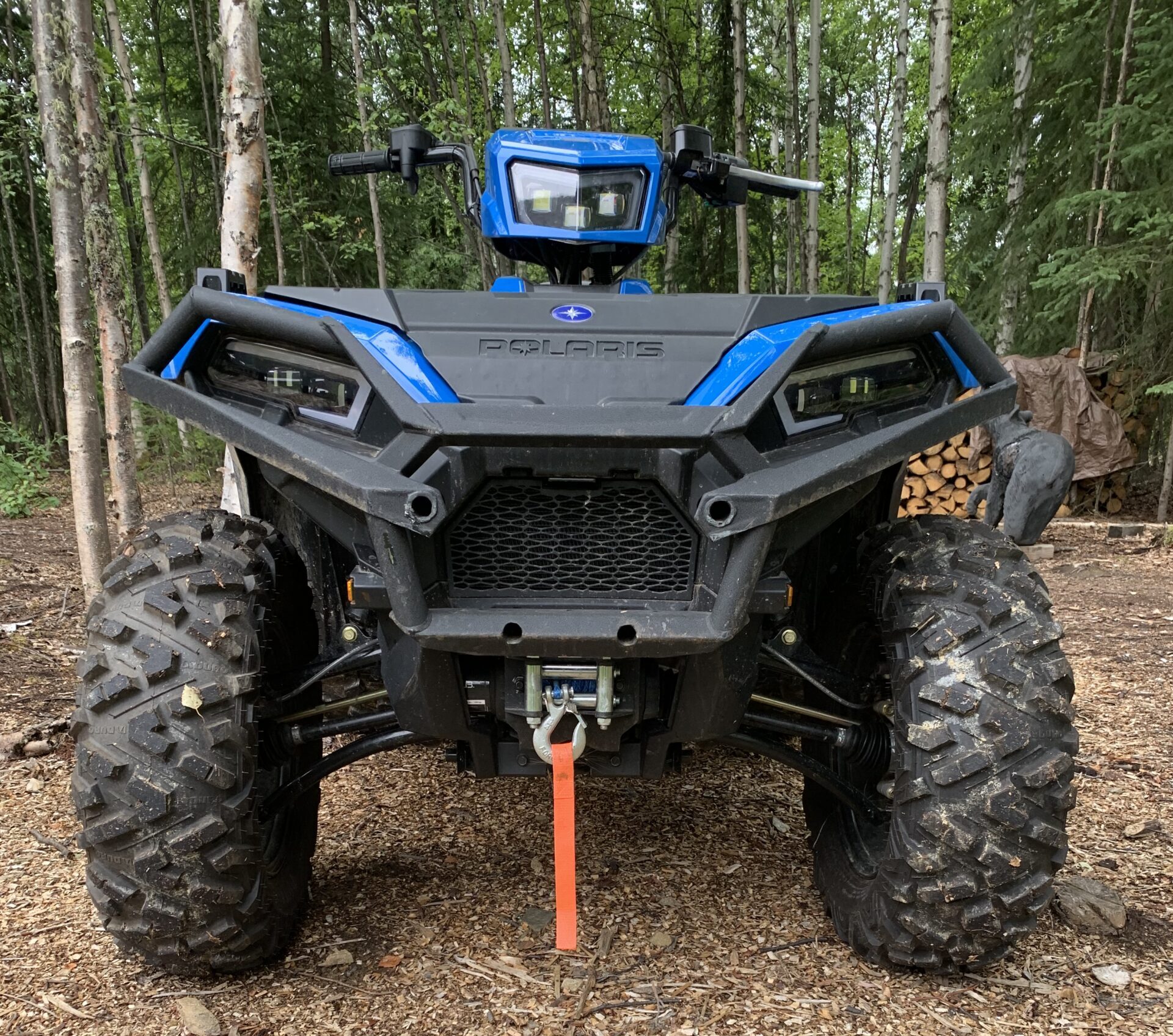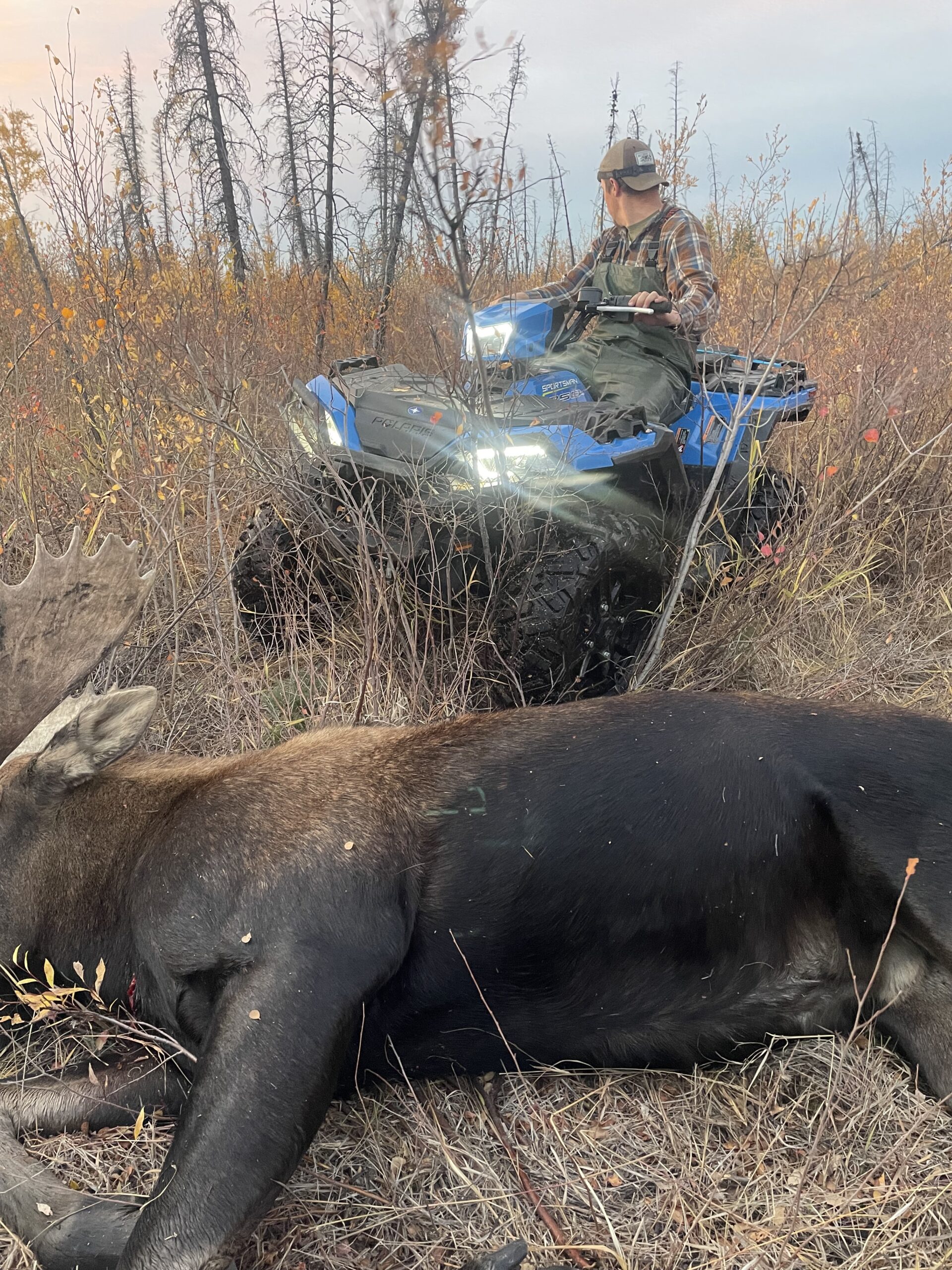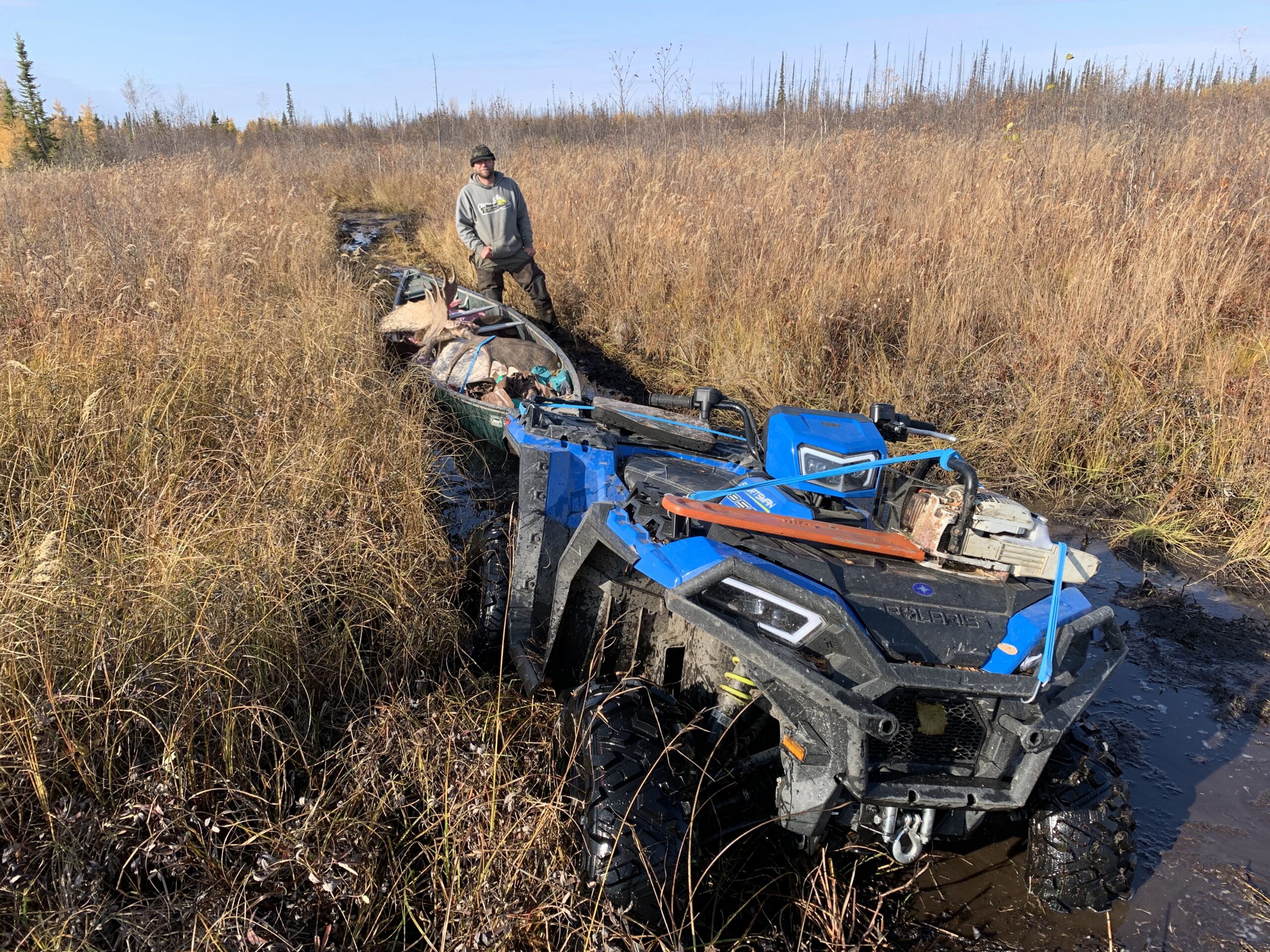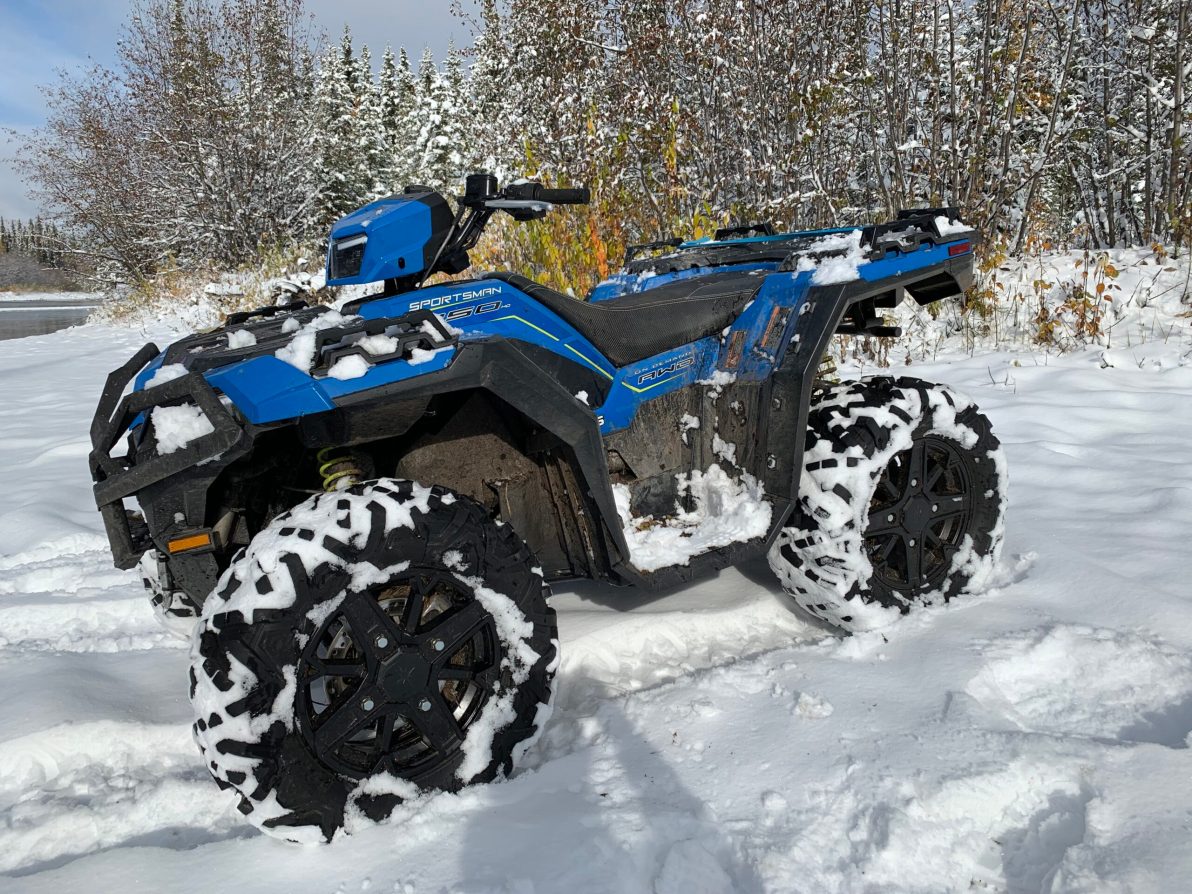We may earn revenue from the products available on this page and participate in affiliate programs. Learn More ›
Testing gear and equipment is a nuanced endeavor. Often, the best test is to put equipment to use and see how it stands up. We ask a lot of our ATVs here in Alaska. Running one through a moose season will reveal what it does well, and what it doesn’t.
This season, I had the opportunity to test the Polaris Sportsman 850 Ultimate Trail Edition. After a boat ride, bogging across swamps, crashing through brush, hauling camp into (and two bull moose out of) the bush, I have a good handle of just how capable it is. There are plenty of aftermarket upgrades that make an ATV more suited for Alaska, but I didn’t make any changes to the Polaris. It was the same floor model anyone can buy. Here’s how it performed.
Polaris Sportsman 850 Specifications and Features
- Engine: 2-Cylinder 850cc 4-stroke 78HP
- Drive System: One-touch AWD/2WD with Active Descent Control
- Steering: Electronic Power Steering
- Instrumentation: All-digital Bluetooth-compatible display
- Cooling: Liquid
- Fuel System: Electronic Fuel Injection
- Battery: 400 Cold Cranking Amps
- Transmission: Automatic w/in-line shifting P, R, N, L, H
- Tires: 27-inch DURO 6-ply
- Dry Weight: 864 pounds
- Fuel Tank: 5.25 gallons
- Ground Clearance: 12 inches
- Towing: 1.25-inch hitch receiver, 1,500-pound capacity
- Wheelbase: 53 inches
- Width: 48 inches
- Suspension: Sealed high-clearance arched A-arms
- 3500-pound winch with synthetic rope
- Front and rear bumpers
- In-Pod battery charging port

Polaris Built This ATV for the Backcountry
The Sportsman 850 is a beast of a machine. It’s big, powerful, and high-tech. Weighing roughly 900 pounds with fuel and fluids, it’s a heavy rig, but the high-clearance A-arms and 27-inch tires give it incredible ground clearance for a factory ATV. This is balanced with a 48-inch width that provides great stability while staying under the 50-inch threshold that some areas have allowed for ATV/UTV use. The Ultimate Trail Edition can do a lot more than trail riding, with a 3500-pound winch, synthetic rope, and heavy-duty front and rear bumpers. The bumpers provide great protection while crashing through brush, and the front bumper is set up to use a plug-and-play light bar.

Like many Sportsman models, this one features plastic cargo racks on the front and back of the machine, which are reinforced with a steel frame and feature steel anchor points that are compatible with Polaris accessories. The front cargo rack is held down with two latches, and flips up to open a large, sealed storage space, and access to the fuse panel, battery, and coolant tank. The sealed fuse panel is a great add-on, as I have burned fuses and melted non-sealed fuse panels in older machines crossing deeper water. Many previous models of the Sportsman ATV had a rear storage compartment on the back of the machine under the cargo rack. On the 850, this gasket-sealed tool compartment door is integrated into the rack itself. This helps to keep it out of the water, but it does require you to move cargo if you need to access it and have gear tied down on top.
The speedometer cluster and electronics are all digital and very advanced, allowing a more active user interface than with models of years past. The digital display can be programmed to display info like speed and fuel level, as well as ambient temperature, coolant temperature, RPM’s, engine hours, and voltage. It will also display any alerts or failures that it detects. I found it handy to display both RPM and coolant temperature. Sometimes an ATV’s radiator can become caked in mud or other debris, and you can see the bump in temperature before it overheats and goes into limp mode. This machine is entirely reliant on a battery, which can give some folks misgivings about its reliability in the backcountry. Fortunately, there are plenty of portable jumper packs available to jump-start your machine if you happen to drain the battery somehow. With diligent maintenance, though, the 400 CCA battery will serve you well, and even after sitting for a couple weeks in sub-zero temperatures, the fuel-injected motor fired right up for me.
The Power of the Polaris Sportsman 850
The 850cc, 78-horsepower motor packs a lot of power, and has excellent throttle response and torque, especially in low gear. The hitch has a 1500-pound tow rating, and on my moose hunt, it had no problem pulling around two bull moose to position for field-dressing with the winch rope. We had to haul a lot of gear back through the swamps to get to moose camp, and the only thing we really could have benefitted from was a set of good mud tires. The 27-inch DURO tires that come on the Ultimate Trail Edition are certainly better than standard stock tires but aren’t ideal for boggy terrain, though they aren’t meant for swamps. The 6-ply tires are great for their intended purpose—trails and dry, rocky country. They are wide and provide a soft footprint, and aside from towing heavy weight, they did surprisingly well in the muskeg. If you’re looking at tires for muddy or swampy applications, a good set of mud tires will give you access to more of the motor’s power.

Polaris Made the 850 More User Friendly
As with most modern ATVs, the 850 has a liquid-cooled engine, with a radiator located behind the front brush bumper. The placement of the radiator gives it protection, but it can easily become clogged in certain conditions. Mud or other debris can cake it and reduce its heat-transmission, and I ran into an issue with cotton-like seeds from fireweed. Fortunately, I was watching the temperature on the display and was able to stop the machine and clean off the radiator by removing the plastic grill, a handy feature that can save you a lot of headaches.
Polaris is known for comfortable-riding ATVs. The independent suspension on this model has 9 inches of travel on the front and 10.25 inches at the rear (with independent pre-load adjustments on all shocks). The suspension design and width of this machine make for stable and smooth rides, even on steep or uneven terrain. Narrower machines with stiffer suspensions can sometimes be very tippy on side-hill riding, and even without using wheel spacers, this Sportsman rides like a Cadillac. The curved A-arms provide ample clearance, and the front suspension and steering are generally less-busy than older Sportsman models. This means there are fewer parts that will hang up on sticks, brush, and potentially get broken off-trail. Older models also had a tie rod end that was so close to the tire, it required wheel spacers if you wanted to use aftermarket mud tires. On this one, everything is up inside the 14-inch tire rim, giving some added protection. The electronic power steering on this ATV is absurdly nice. It’s so soft, in fact, that if you’re driving at high speeds, you must be very careful not to over-steer. After using this 850 in moose camp, driving my older model Sportsman feels like steering a paint shaker.
What the Sportsman 850 Ultimate Trail Does Best
This machine is a dream to drive. The soft suspension, exceptional power steering, and ground clearance make for a ride that is hard to beat. In tough country, this reduces rider fatigue and makes the experience more enjoyable. It travels over tussocky and rocky terrain with ease; some lower-riding machines would frequently get high-centered. I like that this package comes with better-than-stock tires and a winch, two absolute essentials for any ATV in Alaska. The low-end torque and throttle response were excellent, and the quad pulled heavy loads easily without having to work it very hard. Despite weighing 900 pounds, the tires do well at spreading the weight and it had no trouble traversing muddy terrain and floating bog when I wasn’t towing anything behind it.
Where the Sportsman 850 Ultimate Trail Struggles
Compared to some other ATVs, the 850 is a gas hog. This comes with the territory of a more powerful motor, especially when you’re working it hard. It’s not much of an issue if you plan for it, but it seems to guzzle through the 5.25-gallon tank quickly. At moose camp this year, each round-trip to the boat while pulling a trailer would burn about 3 to 3.5 gallons of gas as opposed to 1.5 to 2 gallons with a smaller 400cc Sportsman. My only other complaint about this model isn’t unique to just this model. For towing, it has a 1.25-inch hitch receiver that’s integrated into the ATV’s frame. A machine this big and powerful should really use a 2-inch hitch receiver. With heavy towing over rough terrain, the hitch pin holes in the receiver quickly begin to wallow out, and eventually, you may need to have the receiver cut off and a new one fabricated.
Final Thoughts on the Polaris Sportsman 850
All-around, the Ultimate Trail Edition is a great machine. Everyone has their preferences and uses their ATV in a different way, but for a factory package, this machine comes well-equipped for a wide variety of locations and uses. Polaris made this rig powerful and comfortable, but also simplified the component layout to make it easier to use. They reduced the clutter in the front suspension and steering too, which makes this 4×4 a superior machine to drive Plug-and-play accessories are simple to install, and the battery and fuse panel are easy to access, making it a very user-friendly four-wheeler. That makes a big difference on backcountry hunts where anything and everything can go wrong. I’ll miss the Polaris’ ease-of-use next moose season.
